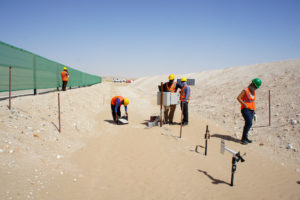
THE PHYSICS WINDBLOWN SAND
The physics of windblown sand sets its origins on the scientific contributions of the Brigadier Ralph Alger Bagnold that, since the Thirties, has dedicated part of his life to understand the aeolian sand transport and desert structures such as sand dunes, ripples and sheets. Bagnold’s and his followers’ models are based on sound mathematical and scientific approaches that are founded on experimental observation in the ideal condition of planar transport surface.
The desert complex morphology, the need of accounting for local site effects and the peculiar characteristics of different sands lead to significant differences between theoretical and observed sand transport and evidence the complexity of the real three-dimensional context.
The experimental study of the windblown sand transport has been implemented through 10 monitoring stations set up with standard instruments, for the acquisition of the environmental data, and custom instruments designed specifically for acquiring the physical quantities of interest. The trial field tests have unequivocally demonstrated the only partial applicability of theoretical models, showing for example strong limitations in approaches based on the adjustment of theoretical fluxes by correction factors.
The experimental activity confirmed the necessity of a pointwise quantitative approach for the particular real situations and the requirement of a specific design for each geomorphological environment.

SAND MITIGATION MEASURES DESIGN AND EXPERIMENTAL TESTING
The on site observation of the different sand mitigation solutions at the 12 field trials was determinant in the optimization process towards the final solution.
The real scale trial fields were built at 12 different special positions in the UAE desert, following different geographic orientations, geomorphological conditions, environmental parameters and preliminary windblown sand study results.
Several Sand Mitigation solutions were built and tested during the experimentation. Different materials were employed: natural (such as sand and other aggregates), artificial (polymeric and metallic) and mixed.
All the 12 field trials were equipped with a complex monitoring system set up with the most advanced electronics, sensors and with custom, specifically designed, instruments.
The data from trial fields have been acquired more than two years. Thanks to the continuous data acquisition the Sand Mitigation systems efficiency has been constantly analyzed and the predictive models have been refined and updated. The Sand Mitigation systems have been gradually re-engineered and modified until their optimal efficiency was reached.


 Italiano
Italiano